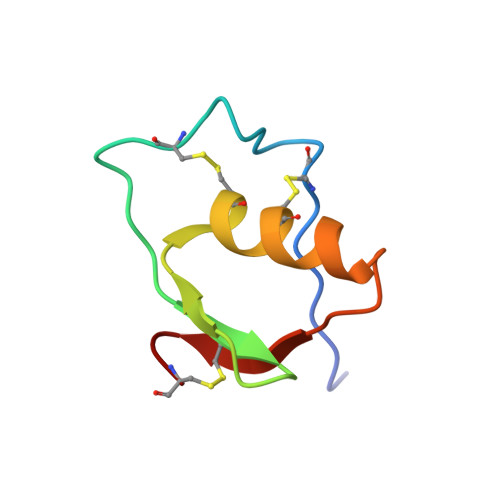Two conformational states of Turkey ovomucoid third domain at low pH: three-dimensional structures, internal dynamics, and interconversion kinetics and thermodynamics.
Song, J., Laskowski Jr, M., Qasim, M.A., Markley, J.L.(2003) Biochemistry 42: 6380-6391
- PubMed: 12767219
- DOI: https://doi.org/10.1021/bi034053f
- Primary Citation of Related Structures:
1M8B, 1M8C - PubMed Abstract:
Turkey ovomucoid third domain (OMTKY3) is shown to exist at low pH as two distinctly folded, interconverting conformations. Activation parameters were determined for the transition, and these were of the type reported previously for cis/trans isomerizations of prolyl peptide bonds. Multidimensional, multinuclear NMR spectroscopy was used to determine the three-dimensional structure of each of the two states of P(5)-Pro(14)Asp OMTKY3 at pH 2.5 and 25 degrees C, under conditions where the two states have equal populations with interchange rates of 0.25 s(-1). The results showed that the two states differ by cis/trans isomerization of the P(8)-Tyr(11)-P(7)-Pro(12) peptide bond, which is cis in the conformer dominant at neutral pH and trans in the conformer appearing at low pH. The major structural differences were found to be in the region of the reactive site loop. The core of the protein, including the antiparallel beta-sheet and a alpha-helix, is preserved in both structures. The state with the cis peptide bond is similar to previously reported structures of OMTKY3 determined by NMR spectroscopy and X-ray crystallography. The cis-to-trans transition results in the relocation of the aromatic ring of P(8)-Tyr(11), disrupts many interactions between the alpha-helix and the reactive-site loop, and leads to more open spacing between this loop and the alpha-helix. In addition, the configurations of two of the three disulfide bonds, P(11)-Cys(8)- P(20)'-Cys(38), and P(3)-Cys(16)- P(17)'-Cys(35), are altered such that the C(alpha)-C(alpha) distances for each disulfide bridge are longer by approximately 1 A in the trans state than in the cis. Mutations at P(1)-Leu(18), P(6)-Lys(13), and P(5)-Pro(14) influence the position of the cis <= => trans equilibrium. In P(1)-Leu(18)Xxx OMTKY3 mutants, the trans state is more favored by P(1)-Gly(18) than by Ala(18) or Leu(18); in P(6)-Lys(13)Xxx OMTKY3 mutants, the trans state is more favored by P(6)-Glu(13) and P(6)-Asp(13) than Lys(13) or His(13). Stabilization of the trans state in P(5)-Pro(14)Xxx OMTKY3 mutants follows the series Xxx = Gly > Asp > Glu > Ala approximately equal His > Pro. In comparing the state with the trans peptide bond to that with the cis, the pK(a) values of P(12)-Asp(7) and P(1)'-Glu(19) are higher and those of P(9)-Glu(10) and P(25)'-Glu(43) are lower. The pK(a) values of other titrating groups in the molecule are similar in both conformational states. These pK(a) changes underlie the pH dependence of the conformational equilibrium and can be explained in part by observed structural differences. (15)N transverse relaxation results indicate that residues P(6)-Lys(13)-P(3)-Cys(16) in the trans state undergo a dynamic process on the microsecond-millisecond time scale not present in the cis state.
- National Magnetic Resonance Facility, Department of Biochemistry, University of Wisconsin-Madison, 433 Babcock Drive, Madison, Wisconsin 53706, USA.
Organizational Affiliation:
















